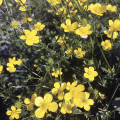Fish Attractors
Fish Attractors
Attracting Fish
The primary purpose for many farm ponds is recreational fishing. With proper management, even small ponds can provide excellent fishing. One of the best ways to enhance the fishing experience is to create fish attractors at strategic locations in a pond or lake with a well-managed fish population.
Game fish such as bass and bream are attracted to cover or shelter of all types. Shelters provide areas where prey fish can hide from predators and where predators can find prey species. They also provide spawning areas and harbor large numbers of invertebrates and insects that small fish feed on.
Natural cover that provides shelter for fish includes ditches, creeks, trees (standing or tree tops), stumps, vegetation, and other irregular features of the bottom. In ponds where natural shelter for fish is missing or inadequate, you can establish artificial structures to act as fish shelters that will attract and hold fish.
Trees as Fish Attractors
You can develop fish shelters that will increase fish harvest and angling success in existing ponds with small trees such as blackjack oaks, post oaks, or cedars. Discarded Christmas trees make good temporary shelters, but they decompose quickly and must be replaced often.
For small ponds, bushy-crowned trees 10 to 15 feet tall are sufficient. You can use larger trees in larger lakes. In ponds smaller than 1 acre, one brush shelter is enough. Larger ponds need one or two shelters per acre. Select attractor sites anglers can reach. Good locations are in water 4 to 8 feet deep near creek channels, near points, or at drop-offs.
Drive a stake or use a floating buoy to mark the shelter site permanently. Place three to five trees at each location. Green trees will usually sink without weights. Some trees, such as cedar, will float. Add weights to these varieties to keep the shelters in place.
Many new pond sites have trees in the basin. Cut and salvage most of these, then cut and pile or burn them. You can keep some trees, bushes, and brush piles to use in establishing fish shelters. From 10 percent to no more than 25 percent of the pond area can have some tree shelter.
Leave bushes and trees in deeper water areas, along creek runs, and in the middle of ponds and lakes. Leave the trees in small clumps, then cut the standing trees about 2 feet above the normal water level, and anchor the brushy tops to the bases of the stumps. The tall stumps serve as permanent markers for the shelter locations. Do not leave trees or bushes in shallow areas, in narrow coves, or along pond banks, because these areas will become difficult to fish and may develop weed problems. Also, too much cover in shallow water makes it hard for bass to effectively feed on bream and prevents navigation of the entire shoreline by boat. Fish will immediately inhabit brush-top shelters.
Gravel Beds as Fish Attractors
Gravel beds are extremely attractive to bream for spawning, and bream will use these gravel beds frequently throughout the spring and summer. Select an area in water 3 to 4 feet deep that is convenient for fishing. Drive a stake to mark the spot, and place washed gravel (½-inch diameter) around the stake, creating a bed of gravel 4 to 6 inches deep. A 3- to 5-cubic-yard load makes a gravel bed 12 to 15 feet wide.
For best results, you can provide a frame to hold the gravel in place. If the frame is made of treated lumber or other material that can float, make sure the frame is securely anchored to the bottom. You can add gravel beds to flooded sites or strategically place them during drawdowns. Avoid sites that have a high silt erosion problem.
Other Fish Attractors
If trees or brush piles are not available, you can place other types of structures in the pond to attract fish. Developing irregular bottom features during construction, such as ditches and underwater dirt mounds, also provides fish-attracting cover and creates excellent places to fish. Humps that rise to 3 to 4 feet of depth and are surrounded by deeper water are fantastic fish attractors, especially in combination with brush piles or gravel beds.
Publications
News
Whether you have a large lawn, field, or pasture, you’ve probably had to deal with pesky weeds.
BILOXI, Miss. -- The Southeast has some of the most commercially and recreationally valuable fisheries in the United States.
Success Stories
Billy Mitchell spent his childhood summers in the water and has lived at Pelahatchie Bay for more than three decades, so his dedication to protecting water resources now almost makes too much sense.






